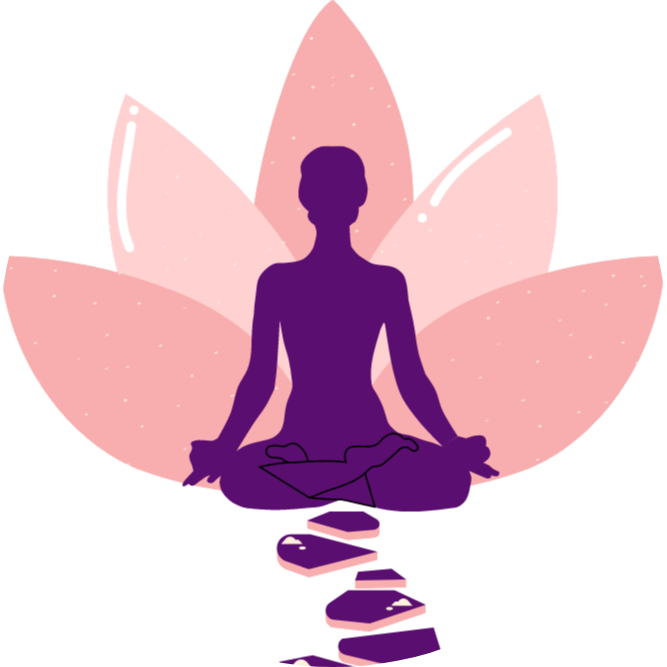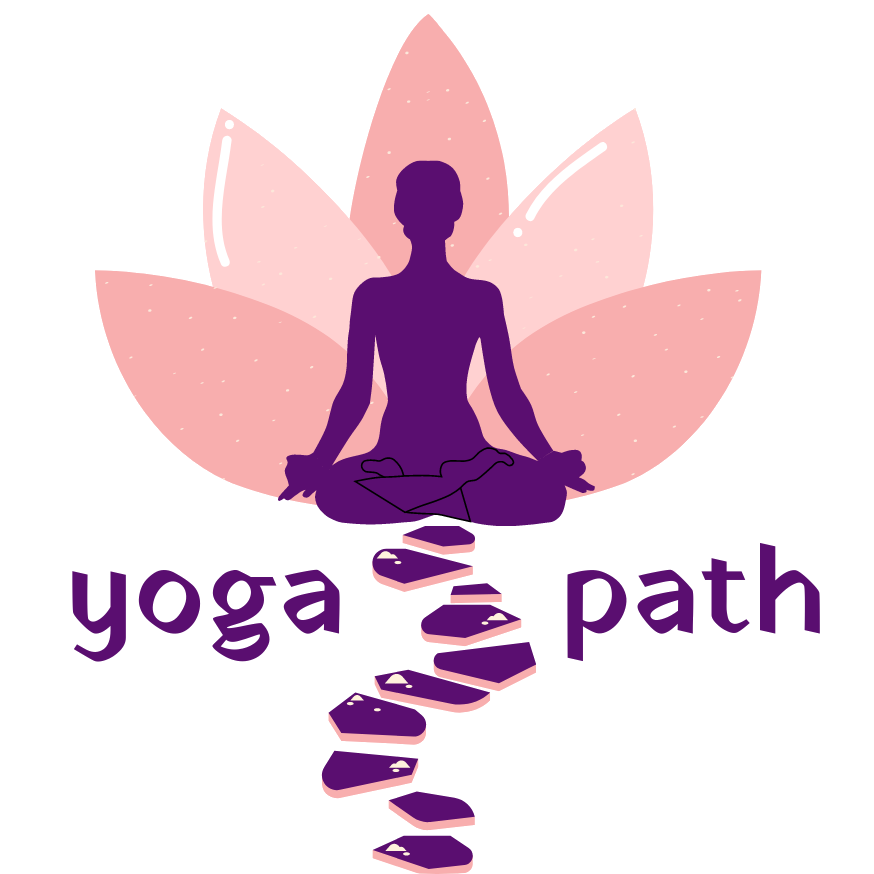Heart Health with Yoga
ASANAS FOR HEART HEALTH
Cardiovascular disease claims the lives of 1 in 3 women.
One is too many!
February is titled as the Heart Month to promote cardiovascular health and raise awareness about heart disease. This month is an amazing opportunity to focus our time and attention on ways to improve and maintain heart health.
Here are 9 asanas which help improve heart health.
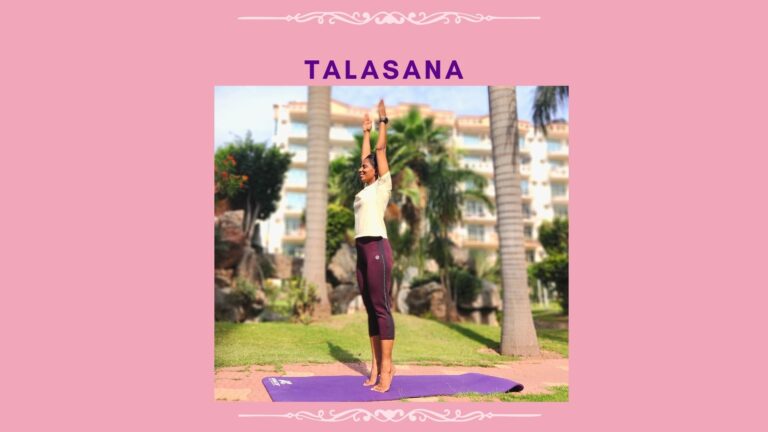
Talasana
Standing Position – Upward Stretch
In this pose, stand erect with hands at their respective sides. Keep the feet parallel to each other and maintain a one-foot distance between them.
1. Inhaling, raise both arms up above head. Keep the arms close to the ear.
2. Simultaneously, raise both the heels, to achieve a maximum stretch of the body.
Synchronise the first two steps, while inhaling, in 3 seconds.
Now, balancing on the balls of the feet, with the completed upward stretch of the arm and the body, keep the gaze straight ahead and maintain the pose for 6 seconds, retaining the breath (final position).
Return to starting position:
Turn the palms to face outward and then exhaling, bring the arms down keeping them straight through a backward and downward circuit. Simultaneously, lower the heels to assume the starting position.
Contraindications:
Frozen shoulders, Arthritis, Hypertension and serious cardiac complaintsBenefits:
Helps increase the girth and contour of the chest.
Develops the respiratory muscles and the vital index.
Improves elasticity, capacity and circulation of the lungs.
Improves the venous flow –equalises blood circulation.
The flexibility of the spinal column improves.
Tenses/tones the usually relaxed muscles of the abdomen.
Muscles of the leg are toned and improvement in the functioning of the veins.
Due to the stretch of the vertebral column, undue pressure on the vertebrae is relieved.
Trikonasana
Standing Position – Sideward Bend
Trikona meaning Triangle
In this pose, begin with both feet 3 feet apart. Turn the right foot out pointing to the right at a right angle to the left foot.
Inhaling in 3 seconds raise both arms out at shoulder level with palms facing downward.
Exhaling in 3 seconds and gazing at the right palm, extend and lower the right palm to the right foot at the same time raising the left arm straight above .Then turn the gaze to the left thumb of the arm above. The legs and hands are straight. The upper left hand and lower right hand are aligned in one straight line lift the left shoulder up so that the shoulder is also in one line aligned with the arms.
Hold this pose for 6 seconds.
As you exhale in 3 seconds turn your gaze to the lower arm, raise both arms to shoulder level and lower them down by your sides.
Repeat the same on the left side.
This is one round. Practise 3 rounds.
Contraindications:
Spinal injury, Back injury or Shoulder injury, Frozen shoulder, severe Arthritis, Hypertension and serious cardiac complaints.
Benefits:
Stretches, develops and tones the muscles of the sides and the obliques
Strengthens the back and improves posture
A very good compression and twist to the abdomen and the organs therein
Improves digestion
Stimulates the nervous system
Relieves symptoms of menopause
Gomukhasana
Sitting Position
Gomukhasana literally translates into a cow face posture (go – cow, mukha – face, asana – pose). A seated yoga posture, Gomukhasana can be performed along with a set of different seated asanas.
Sit on the yoga mat with your legs folded comfortably in sukhasana.
Raise the left arm above your head and bend the upper arm backward at the elbow. Simultaneously, bring the right arm behind your back from down and interlock both hands.
Take deep breaths and stay as long as you are comfortable.
Now, as you exhale, release your arms.
Beginner’s tip:
Your left hand may not be able to reach the right hand and vice-a-versa initially. In which case, do not exert too much force. With practice of holding a scarf or belt in between both hands and slowly by inching forward toward each hand you will be able to hold both hands eventually.
Contraindications:
Frozen shoulder, Shoulder pain or injury – refrain from doing Gomukhasana. If the pain in the shoulder is not much, do the posture under the supervision of a trained yoga teacher. People with Soft tissue injury in leg such Muscle tear or pain in thighs, Bleeding piles and those suffering from Spondylitis must refrain.
Benefits:
Cures sciatica
Helps reduce high blood-pressure
Regular practice tones and massages the reproductive organs
Stretches stiff shoulders
Strengthens back muscles
Strengthens wrist and arms
Stretches spine improves posture
Reduces stress and anxiety
Stimulates kidneys and abdominal organs
Strengthens muscles of ankles, hips, thighs, shoulders, triceps, inner armpits and chest.
Paschim Namaskar
Seated Pose
Paschim = west, meaning backside; namaskar = greeting; asana = pose
Paschim Namaskarasana or the Reverse Prayer pose is an upper body strengthening pose that works specifically on the arms and the abdomen. It is also known as Viparita Namaskarasana.
Begin in standing Tadasana or seated comfortably on the chair or your mat. Relax the shoulders.
As you inhale bring your arms behind your back and join the palms with fingertips facing upward.
Ensure that the palms are pressed firmly against each other.
Stay in the position for a couple of breaths.
As you exhale, slowly turn the fingertips downward.
Bring the arms down to the sides and slowly come back into Tadasana or place the palms on the thighs (when seated).
Contraindications:
People with low blood pressure, arm or shoulder injury should avoid doing this pose
Benefits:
Opens the chest improves the muscles for respiration.
Improves lung capacity when used with deep breathing regularly
Stretches the upper back, the shoulder joints and pectoral muscles.
The Thoracic region of spine or upper back is very strong and helps us to stand upright and protects the vital internal organs in the chest But, this area gets limited movement, and to prevent injury or degeneration in these muscles, this asana is very effective.
Strengthens the wrists and arms as well.
Since both palms come together it has the same benefits as Anjali mudra
This asana also releases knotted up tension from your shoulders, forearms, wrists, and collarbones area. It helps strengthen your wrists and makes them flexible. Extensive typing or writing work causes pain in the wrist joints Paschim Namaskar asana, helps open and relaxes this joint. Amazing counter-pose for activities that require griping your hands. It is very effective for neck and back pain. It relieves the tightness and pain due to tension in these muscles.
Doing this asana helps in promoting digestion and also helps in maintaining your metabolism and energy levels.
It increases range of movement in shoulder, and arms.
It improves body posture. It is very effective in reducing stress and calming the mind.
A must for people suffering from negative emotions like anger, sadness, anxiety – practise ‘Paschim Namaskar Asana’ daily.
It activates and opens the heart chakra or Anahata Chakra.
Ushtrasana
Sitting Position – Backward Bend
Ushtrasana meaning Camel Pose
Sit in Vajrasana then come into a kneeling position on the mat.
Slowly, lean backwards, and take the arms behind.
Place the palms on the heels.
Keep the arms straight, inhaling in 3 seconds, slowly lift the pelvis and chest upward and outward. Allow the neck to fall backwards gently. Slowly maintain the final position for 30 seconds to 1 minute. Breathing should be normal – slow and rhythmic. Exhaling, in 3 seconds, gently draw back the torso and straighten the neck. Releasing the palm, come back to kneeling position. Practice 2 rounds.
Contraindications:
Abdominal inflammations, Ulcers and Slip Disc
Benefits:
Stretches back shoulder and neck.
Stretches thighs, abdomen, thorax, neck and facial muscles.
Alleviates constipation.
Relieves back pain.
Improves posture by correcting drooping shoulders and rounded back.
Improves breathing by opening up the chest; hence, good for asthmatics.
Stimulates and regulates ovaries, thyroid and other glands.
Improves stamina and self esteem.
Prone Position – Back Bend
Bhujanga Asana meaning Cobra Pose, is also a part of the Surya Namaskar (salute to the sun)
Lie down on your abdomen with your toes flat on the floor, soles facing upwards; rest your forehead on the ground. Keep your legs close together, with your feet and heels lightly touching each other. Place both palms beside the chest elbows should be bent and close to your torso.
As you inhale slowly lift your head, chest and upper part of abdomen. Keep your navel on the floor. Keep elbows close to body.
Keep breathing with awareness, as you curve your spine upward vertebra .by vertebra look straight ahead. Maintain this pose for a few seconds while breathing evenly for 4-5 breaths.
Now, breathe out, and gently bring your abdomen, chest, and head back to the floor and relax.
Contraindications:
Hernia, Hypertension, Heart Ailments, Pregnancy, Peptic ulcer and Hyper thyroid
Benefits:
Helps align vertebra
Strengthens Muscles of Back and spine and keeps spine flexible
Relief from back pain
Stimulates spinal nerves
Tones abdominal muscles And organs
Alleviates constipation
Stimulates appetite
Prevents diseases by aiding in elimination through intra abdominal pressure
Relief from flatulence
Helps resolving slipped disc
Relief in Ankylosing Spondylitis and kyphosis
Helps in menstrual and gynaecological disorders
Strengthens willpower alertness and increases determination
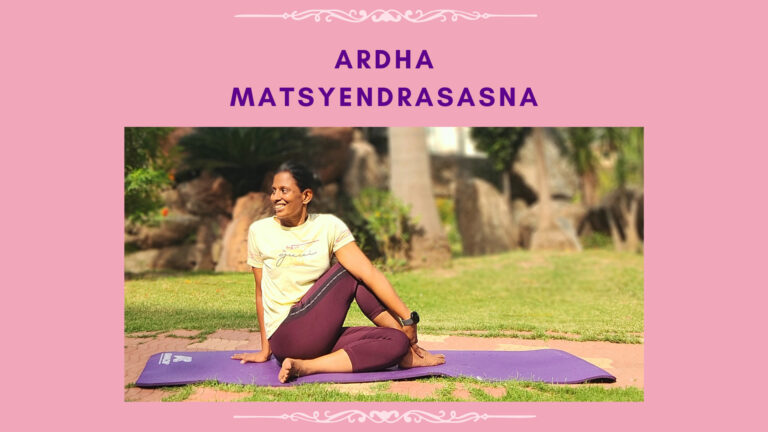
Ardha Matsyendrasana
Seated Pose – Half Spinal Twist
Ardha Matsyendrasana is named after Rishi Matsyendranath who was a Hatha Yoga proponent and his favourite meditation asana was a full spinal twist itt was simplified so that everyone could also practise which we know as Ardha Matsyendrasana.
In this asana, sit on the mat with the legs stretched out straight in front of you, keeping the feet together and the spine erect. Bend the left leg, place the left heel beside the right hip. Take the right leg over the left knee place the right foot close to the left knee. Place the left hand on the right knee and the right hand behind you. Twisting the waist, shoulders and neck to the right look over the right shoulder. Keep the spine extended straight and erect. Hold while breathing in and out. Release the right hand first (the hand behind you), unwind the waist, then chest and the neck and sit up relaxed and straight. Repeat on the other side.
Contraindications:
Hernia, peptic, ulcer and severe spinal problem, as well as people who went for abdominal, heart or brain surgery. Pregnant women should not twist.
Benefits:
Increases the elasticity of the spine makes it supple which further help to relieve stiffness between the vertebrae and prevent back pain.
Benefits people with a mild slip disc problem.
Opens the chest and increases the oxygen supply to the lungs.
Helps to increase the digestive secretions by opening the chest.
Helps to strengthen abdomen, chest, spine, arms and hips
Loosens up the hip joints by relieving stiffness.
Increases the blood circulation to the pelvic region as well as enhance the functions of the reproductive system.
Helps heal piles and fissures due to good blood circulation.
Helps to prevent menstrual disorders and urinary tract related problems.
Helps relieve diabetics. The deep stretch and intense breathing work activates the pancreas by massaging and stimulating it.
Bhujangasana
Prone Position – Back Bend
Bhujanga Asana meaning Cobra Pose, is also a part of the Surya Namaskar (salute to the sun)
Lie down on your abdomen with your toes flat on the floor, soles facing upwards; rest your forehead on the ground. Keep your legs close together, with your feet and heels lightly touching each other. Place both palms beside the chest elbows should be bent and close to your torso.
As you inhale slowly lift your head, chest and upper part of abdomen. Keep your navel on the floor. Keep elbows close to body.
Keep breathing with awareness, as you curve your spine upward vertebra .by vertebra look straight ahead. Maintain this pose for a few seconds while breathing evenly for 4-5 breaths.
Now, breathe out, and gently bring your abdomen, chest, and head back to the floor and relax.
Contraindications:
Hernia, Hypertension, Heart Ailments, Pregnancy, Peptic ulcer and Hyper thyroid
Benefits:
Helps align vertebra
Strengthens Muscles of Back and spine and keeps spine flexible
Relief from back pain
Stimulates spinal nerves
Tones abdominal muscles And organs
Alleviates constipation
Stimulates appetite
Prevents diseases by aiding in elimination through intra abdominal pressure
Relief from flatulence
Helps resolving slipped disc
Relief in Ankylosing Spondylitis and kyphosis
Helps in menstrual and gynaecological disorders
Strengthens willpower alertness and increases determination
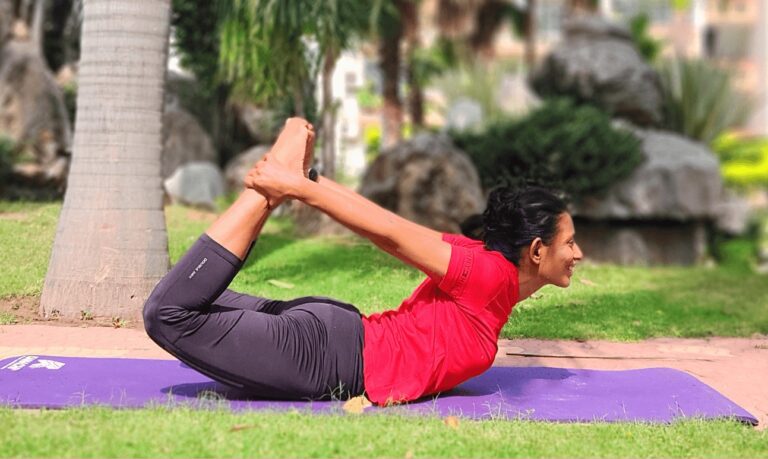
Dhanurasana / Bow Pose
Prone Position / Lying Down Asana
The Asana resembles a bow or dhanusha, hence the name.
Lie on the stomach (prone position), on a mat, legs stretched out straight and feet together with toes pointing outwards.
Slowly, raise the head and the neck and simultaneously bend the legs at the knees. Grasp the ankles of the legs with the respective hands.
Inhaling, in 3 seconds, raise the head upwards, Simultaneously, pull the legs also upwards to give the body a bow shape.
Hold this pose for 6 seconds.
Exhaling, in 3 seconds, bring the head down and simultaneously, release the ankles and unfold the legs.
Remember to raise and lower each vertebrae slowly relieving the spinal pressure by stages. Practice 3 rounds. Hold the final position for 30 seconds and slowly till 2 minutes (start with 30 seconds) – breathing should be normal, slow and rhythmic.
Contraindications:
Hernia, hyper tension, heart ailments, pregnancy, peptic ulcers, serious spinal aliments and osteo-arthritis. People with a protruding belly will have difficulty in assuming a prone position.
Benefits:
Abdominal area gets a very good massage.
The internal abdominal organs and reproductive organs also get a good circulation.
Regulates menstrual cycle.
Stretches to abdominal and pelvic muscles.
Strengthens muscles of thighs and legs.
Stretches the intercostal muscles and improves respiration.
Prevents diseases by aiding elimination through intra- abdominal pressure.
Provides relief from flatulence and indigestion.
Relieves back pain.
Helps in resolving slipped disc.
Helps relieve Ankylosing Spondylitis.
Alleviates constipation and helps in menstrual disorders.
Strengthens the will power by increasing determination and alertness towards precision in functioning.
